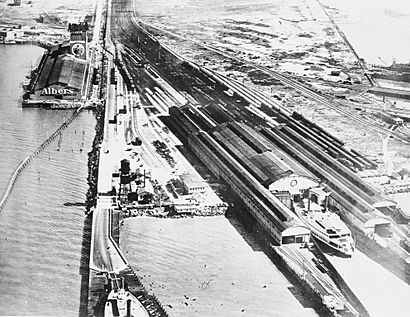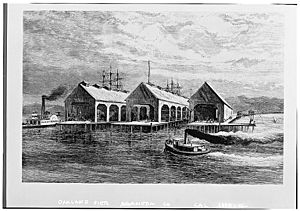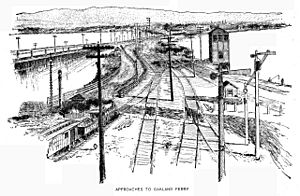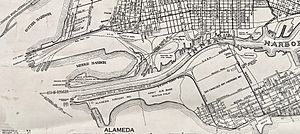Oakland Long Wharf facts for kids
Quick facts for kids
Oakland Pier
|
||||||||||||||||||||||||||||||||||||||||||||||||||||
|---|---|---|---|---|---|---|---|---|---|---|---|---|---|---|---|---|---|---|---|---|---|---|---|---|---|---|---|---|---|---|---|---|---|---|---|---|---|---|---|---|---|---|---|---|---|---|---|---|---|---|---|---|

Oakland Pier sometime after 1919
|
||||||||||||||||||||||||||||||||||||||||||||||||||||
| Coordinates | 37°48′36″N 122°19′34″W / 37.810°N 122.326°W | |||||||||||||||||||||||||||||||||||||||||||||||||||
| Former services | ||||||||||||||||||||||||||||||||||||||||||||||||||||
|
||||||||||||||||||||||||||||||||||||||||||||||||||||
|
Invalid designation
|
||||||||||||||||||||||||||||||||||||||||||||||||||||
| Designated: | 1981 | |||||||||||||||||||||||||||||||||||||||||||||||||||
| Reference #: | 49 | |||||||||||||||||||||||||||||||||||||||||||||||||||
The Oakland Long Wharf was a very long pier built into San Francisco Bay. It was about 11,000 feet long, which is over two miles! This huge structure was used for both trains and ferries. It was located in West Oakland, California.
The Central Pacific Railroad started building the wharf in 1868. It was built on a spot called Oakland Point. On November 8, 1869, it became super important. It was the western end of the First Transcontinental Railroad. This was a railway that connected the east and west coasts of the United States.
In the 1880s, the Southern Pacific Railroad took over. They made the pier even bigger. They also built a new ferry terminal building. This new station was officially called Oakland Pier. People often called the whole structure the Oakland Mole. Parts of this amazing structure were still around until the 1960s. Today, the area is part of the Port of Oakland. Modern passenger trains now use the nearby Jack London Square/Dellums Station.
Contents
History of the Oakland Long Wharf
The area where the wharf was built was first used for boats in 1852. A smaller pier called Gibbons' Wharf was built there. In 1862, Gibbons' Point was renamed Oakland Point. The wharf then became a ferry landing for the San Francisco and Oakland Railroad.
On November 8, 1869, the Oakland Long Wharf became the main western end for transcontinental trains. Before this, another pier in Alameda was used for a short time.
Central Pacific Railroad's Role
In 1868, the Central Pacific Railroad bought this pier. They renamed it the Oakland Long Wharf. They immediately started making it longer and better. It fully opened for business on January 16, 1871.
The very first train to travel the full transcontinental route left Oakland on the morning of November 8, 1869. The first train arriving from the east came to the Oakland pier that same evening. Local trains for daily commuters also used the pier.
From the Long Wharf, ferries carried both commuters and long-distance passengers. They traveled across the bay to San Francisco. The Central Pacific Railroad also used ferries to move freight to San Francisco starting in 1871.
Between 1879 and 1882, part of the wharf was filled in. This created the Oakland Mole and Pier. It opened on January 22, 1882. A large train station building was built there. It had a corrugated iron and glass roof and was lit by electric lights. This new station opened in February 1881.
Southern Pacific Takes Over
In the 1880s, the Southern Pacific took over the Central Pacific's operations. In 1882, the new Oakland Pier opened. It was about half a mile east of the original Long Wharf's end. The old part was then only used for moving freight. It was finally closed in 1919.
The Oakland Mole became one of the busiest piers in the United States. In 1929, a huge stained-glass window with the Southern Pacific logo was put on the western end of the train shed. When the building was torn down, the window was saved. You can now see it at the California State Railroad Museum in Sacramento, California.
For many years, Oakland Pier was the main way to connect to San Francisco for long-distance travelers. Southern Pacific ran ferries between the San Francisco Ferry Building and Oakland Pier. This was for passengers traveling to places like Chicago in the east or Seattle in the north. From 1949 to 1958, the Long Wharf was also the terminal for the Western Pacific Railroad's famous California Zephyr train.
Changes for Commuter Trains
After January 15, 1939, electric commuter trains stopped going to the Oakland Pier. Instead, they used tracks on the lower deck of the new San Francisco-Oakland Bay Bridge. These trains went directly to the Transbay Terminal in San Francisco.
The Oakland Pier station closed to long-distance train traffic in 1958. The ferry service between San Francisco and Oakland was replaced by buses. These buses traveled over the Bay Bridge. They connected San Francisco's Third and Townsend Depot to the 16th Street Station in Oakland. This station was two miles from the mole.
Demolition of the Pier
Over the years, more and more of the bay's shoreline was filled in around the pier. The Oakland Long Wharf was finally torn down in the 1960s. This was done to make space for the growing Port of Oakland and its container ship facilities.
Today, only one structure remains from the Oakland Long Wharf. It is the Southern Pacific Mole's switchman's tower. This tower was restored and moved to Middle Harbor Shoreline Park.
Other Railroad Piers Nearby
There were other important piers and "moles" along the Oakland shore. From north to south, they included:
- The Key System Pier and Mole: This pier stretched almost to Yerba Buena Island.
- The Oakland Long Wharf/The Oakland Mole and Pier (the subject of this article).
- The Western Pacific Mole: This was built in 1906 and opened in 1910. It closed in 1933. The area is now part of Middle Harbor Shoreline Park.
- The Alameda Mole: This existed from 1876 to the 1930s. It connected San Francisco to Santa Cruz by train. In the 1930s, Pan American built a seaplane port at its base.
- The Alameda Terminal and wharf: This was the original western end of the First transcontinental railroad on September 6, 1869.
Oakland Pier in Movies
The Oakland Mole can be seen in movies from its later years. It appears at the start of the 1957 movie Pal Joey. You can see Frank Sinatra's character arriving by train and then taking the ferry. It also appears in the 1952 film noir movie "Sudden Fear" starring Joan Crawford.




